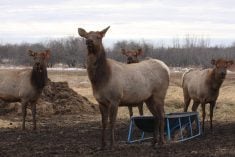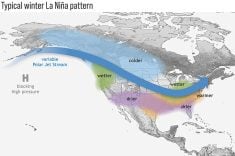Nitrogen calibration strips are a way for growers to gauge nitrogen application and optimize yields,
says a soil fertility specialist with Manitoba Agriculture.
“(They) basically help the grower to have a bit of an eyeball,” said Heard, who works with the department’s crops branch in Carman.
“Did I hit the mark right with my fertility program? Or did I short it? Or did I put on excess?”
The in-field test divides 24 metre long by three metre wide strips into eight three by three metre cells. The first cell has zero nitrogen, the second cell has 30 pounds per acre, the third has 60 lb. per acre and so on until the last cell is treated with 180 lb. per acre of nitrogen.
Read Also

Canadian Food Inspection Agency extends chronic wasting disease control program consultation deadline
Date extended for consultation period of changes to CWD program
According to Manitoba Agriculture’s website, the strips are intended to assess the appropriateness of current nitrogen fertilization strategies.
“(It’s) assurance that you’re putting on enough nitrogen to optimize your yield,” Heard said.
A mid-season strip inspection tells producers which nitrogen rate is producing an appropriate amount of biomass and greenness in the crop.
For instance, a producer may have applied 90 lb. of nitrogen per acre to a canola field.
However, if the 150 lb. per acre cell is greener and producing more biomass than the rest of the field, the producer knows more nitrogen is needed.
The assessment is the tricky part of nitrogen calibration strips.
“The assessment is experience and skill. You can hire to get that or you can study it on your own,” Heard said.
He began promoting the method in Manitoba in 2008 after learning about it from scientists who developed it at Oklahoma State University.
Heard said the test has been well received in Oklahoma.
“The first year they tried these, the farmers chased the fertilizer dealer out of his field. The second year the same farmer was paying the fertilizer dealer to put it in. It proved so beneficial.”
Heard has taught the test to agronomists and consultants across Manitoba, including Ron Tone of Tone Ag Consulting in St. Pierre, Man.
He uses the test as part of his manure management service and has several clients who will use the calibration strips this spring.
Tone said farmers often want to know if they’re using enough manure and how the crop is responding to the manure.
“It’s a good way to see whether the farmer has been putting on an adequate amount of nitrogen.”















